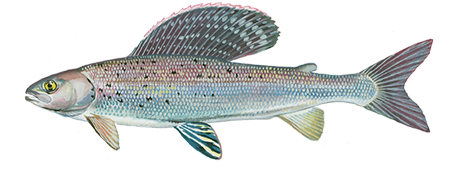Artic Grayling

Arctic Grayling
As its name implies, the Arctic graying is primarily an inhabitant of northern waters.
HOW TO IDENTIFY AN ARCTIC GRAYLING
It is easily recognized by its distinctive sail-like dorsal fin which is followed by a small adipose fin that identifies this fish as a member of the salmon family. In males the dorsal fin is higher and rounded in the rear portion, and in females it is higher in front and somewhat smaller overall. It is a handsome fish due to its graceful lines, large fin, and coloration. Although the colors vary considerably, the body is generally grayish-silver in appearance, usually with faint to prominent overtones or highlights of gold and/or lavender. The body generally has several dark spots, which may be shaped like X’s or V’s in some specimens. The dorsal fin is also spotted. Occasionally a fish may have an entirely golden or silvery appearance, or may be dark blue.
WHERE TO CATCH ARCTIC GRAYLING
It can be found from the Hudson Bay west through northern and central Canada to Alaska as well as in Siberia. Small natural populations occur in Montana and Idaho, and very small transplanted populations occur in these states as well as in Vermont, Wyoming, Colorado, Utah, Arizona, Nevada, and California. The best fishing for this species, however, is in rivers and lakes found in the cold water of Alaska and northern Canada. The following list includes additional details on where to catch this fish:
Outside of Bends Ripples, Currents, Swirls
River and Streams Rock and Boulder Pockets
Dams and Falls Eddies
Undercuts Merging Currents
HOW TO CATCH ARCTIC GRAYLING
They are a superb sport and food fish and are primarily taken by fly fishing. The firm, white flesh has a uniquely delicate flavor unlike any other fish. The following are fishing methods used to catch this fish:
Fly Fishing Still Fishing